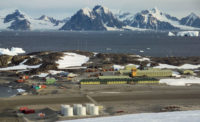Galliford secured a design-build contract with a $39.4-million target price in late 2006, with Broughton and AECOM as subcontractors.
While Galliford handled construction over four Antarctic summers, BAS deployed its local knowledge to manage logistics, says Tuplin.
Getting to the site meant a six-hour flight in an Ilyushin jet from Cape Town to Russia's Novolazarevskaya air base in Antarctica, says Willmott. An old DC3 completed the journey. Another route went through southern Chile and the Falkland Islands.
Ships can't get access much before Christmas and must break through ice for maybe 10 days, says Tuplin. Then, nine weeks at most are left for construction. With the nearest hospital three days away, safety was a higher priority than ever for the 60 workers, adds Willmott.
Galliford and the rest of the team worked with a South Africa-based consortium to develop 5,200 sq m of the 23-centimeter-thick GRP module cladding, building a refrigeration test unit for temperatures around -50 degrees C.
But that effort was spoiled by fabrication errors, says Willmott. "When we loaded the first module onto the ice, it started to crack," he says. Because panel production in Cape Town had been slower than planned, faulty components of only one module went out on the first ship. But with the narrow weather window, recovering from the snags extended the project by two years, says Tuplin. Extra transportation drove a cost increase of nearly 50% to $78 million, he adds.
With the Feb. 5 launch behind the team and the project closing on March 31, Tuplin hopes for work nearer to home. After years of managing construction on the Falklands, he was well qualified for Antarctica's solitude. "I do enjoy working in remote places," he says. "But the plan now is to settle down in this country."



Post a comment to this article
Report Abusive Comment